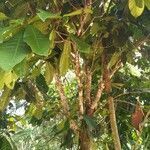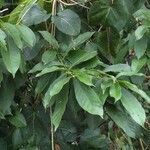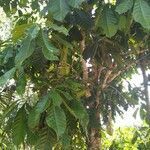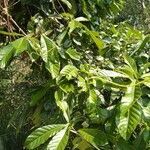Trees; branches and leaf blades glabrous. Young shoots reddish brown, slightly angulate. Petiole 1.5-2.5 cm; leaf blade oblong, ovate-elliptic, or obovate-elliptic, 7-15 cm, leathery, adaxially silver-gray with age, base rounded to broadly cuneate and usually inaequilateral, margin from middle to apex serrulate or rarely entire, apex acuminate, cuspidate, or shortly caudate; midvein slightly impressed from base to middle and slightly raised from middle to apex; secondary veins 10-15 on each side of midvein, prominent to very slender, evident. Rachis of inflorescences glabrous. Female inflorescence ca. 15 cm. Infructescences 8-15 cm. Cupule globose to subglobose, 1.2-1.5 cm in diam., completely or almost completely enclosing nut, irregularly valved, outside yellowish brown puberulent, wall to 1 mm thick; bracts scalelike, 3-or 4-angled, sometimes only base connate, in annular umbones. Nut 1(-3) per cupule, subglobose, 1-1.4 cm in diam., tomentulose, apex mucronulate; scar basal, 7-9 mm in diam. Fl. Apr-May, fr. Oct-Nov.
More
A tree. The branches and leaf blades are smooth. The young shoots are reddish brown and slightly angular. The leaf stalk is 1.5-2.5 cm long. The leaf blade is oblong and 7-15 cm long. It is leathery. It turns silvery grey on the upper surface with age. The base is rounded or wedge shaped and often unequal. The leaf blade can have irregular edges in the top section. They taper to the tip and it can be cup shaped. There are 10-15 side veins on each side of the midrib. The female flower arrangement is about 15 cm long. The cups are 1.2-1.5 cm across. They almost entirely enclose the nut. The outside is brownish and hairy. The are scale like bracts. They are 3-4 angled. There is usually one nut per cup but there can be 3. These are 1-1.4 cm across. They are hairy and the tip is sharp.
Woods; at elevations from 600-1,500 metres. Broad-leaved evergreen forests; at elevations from 200-1,000 metres.
More
They grow in broad leafed forest between 200-1000 m altitude in China.
Can be grown by seedlings. Seeds needs soaking.





